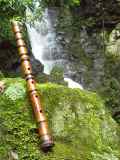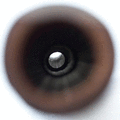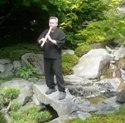Mujitsu and Tairaku's Shakuhachi BBQ
World Shakuhachi Discussion / Go to Live Shakuhachi Chat
You are not logged in.
Tube of delight!
#1 2008-03-28 04:30:09
- radi0gnome
- Member

- From: Kingston NY
- Registered: 2006-12-29
- Posts: 1030
- Website
How do you laquer the bore of a shakuhachi?
It's a really common thing to do, but I can't figure out or find any information on the net about how to do this. I'm thinking maybe using a soaked piece of cloth drawn through like a cleaning rag, or maybe pushing a soaked sponge through. Any other suggestions? I think I'll just oil the bore instead, and for that I suck the oil through like the flute is a straw, but I obviously can't do that with laquer and it seems like a good thing to know how to do.
"Now birds record new harmonie, And trees do whistle melodies;
Now everything that nature breeds, Doth clad itself in pleasant weeds."
~ Thomas Watson - England's Helicon ca 1580
Offline
#2 2008-03-28 07:00:10
- Yooper
- Member

- From: Michigan, on the WI border
- Registered: 2007-11-26
- Posts: 57
Re: How do you laquer the bore of a shakuhachi?
There's a video on the Mujitsu website. Ken uses a long-handled brush.
"Simple and artless."
Offline
#3 2008-03-28 07:34:39
- radi0gnome
- Member

- From: Kingston NY
- Registered: 2006-12-29
- Posts: 1030
- Website
Re: How do you laquer the bore of a shakuhachi?
Hmmm... That raises a lot more questions than it answers.
1) What is a wash?
2) Is it being a wash why he mixes it with turpentine?
3) Is a wash necessary if american laquer is used?
4) What was the tip of that brush like? I have the feeling that if I tried painting with a normal brush it would be at too much of an angle to get paint on the bore.
5) Do the subsequent steps (not wash) get done with a similar brush in a similar manner but with thicker urushi?
It's a very cool video though, thanks for pointing it out.
"Now birds record new harmonie, And trees do whistle melodies;
Now everything that nature breeds, Doth clad itself in pleasant weeds."
~ Thomas Watson - England's Helicon ca 1580
Offline
#4 2008-03-28 09:57:48
- Musgo da Pedra
- Member

- From: South of Brazil
- Registered: 2007-12-02
- Posts: 332
- Website
Re: How do you laquer the bore of a shakuhachi?
In this aspect of shakuhachi making, it appears to be a little no-shared secret... I have asked in a post some days ago how the pro makers do to have the smooth finish on the bore last application of lacquer... no subsequent post.
I have tried the method of pull a cloth inside the bore, but it doesn't shows so efficient action...
What I'm trying now, and I started on two flutes this week, is the method prescribed on the Levenson little manual "Japanese Bamboo Flute". in resume, he says to let the lacquer flow through the bore until the end, and then turn the bamboo about 45° and wait for the movement of the lacquer. And to keep doing until the bore is all lacquered....
This is working fine to me but I'm not using urushi (I'm using a kind of lacquer). I noticed that with a thin lacquer, this works well...
It's a really interesting and important thing to make a beautiful finish job on jiari flutes. I still would like to know how the others pro maker do it (I'm not sure if Levenson still use this method)...
Peace
Omnia mea mecum porto
Offline
#5 2008-03-28 10:26:18
Re: How do you laquer the bore of a shakuhachi?
radi0gnome wrote:
It's a really common thing to do, but I can't figure out or find any information on the net about how to do this. I'm thinking maybe using a soaked piece of cloth drawn through like a cleaning rag, or maybe pushing a soaked sponge through. Any other suggestions? I think I'll just oil the bore instead, and for that I suck the oil through like the flute is a straw, but I obviously can't do that with laquer and it seems like a good thing to know how to do.
If you use a synthetic lacquer, it works well to tape one end of the bore shut (as well as holes) and pour the slightly thinned lacquer inside. Roll, then pour out the other end.
For urushi, a brush works better. (This works for synthetic lacquer as well) There are brushes exclusively for this available at Mejiro which look like toothbrushes. A sponge or foam rubber pad can also be tied to the end of a bamboo stick and soaked in urushi. Then swabbed through the bore. Even ordinary brushes can be bent slightly at the end then tied to a bamboo stick.
Urushi is usually thinned with turpentine or other spirit. A wash is simply a light coat of urushi. To make the urushi opaque more coats are needed. Place in a humid box overnight between coats.
Hope this helps.
Offline
#6 2008-03-28 18:42:38
- Karmajampa
- Member

- From: Aotearoa (NZ)
- Registered: 2006-02-12
- Posts: 574
- Website
Re: How do you laquer the bore of a shakuhachi?
I think Ed mentioned that Monty uses a sponge on a stick to laquer the bore.
I use walnut oilsoaked into a thin cloth that I push through the bore. I leave it to dry for a few weeks then do it again. Walnut oil is slow to dry and harden but eventually I get a good finish, I polishe with 1200 paper between coatings.
Kel.
Kia Kaha !
Offline
#7 2008-06-28 22:13:55
- pablo63
- Member
- Registered: 2006-08-29
- Posts: 25
Re: How do you laquer the bore of a shakuhachi?
i've a natural bore 2.0 non-root end Peter Ross, traveling w/me on the road, it has an utagachi. Does anyone recommend lacquring the bore? you might laugh but i almost agonize over changing the character of this piece of bamboo, though i would like to make a 7 hole out of it.
Offline
#8 2008-06-29 16:22:23
- udo.jeromin
- Member

- Registered: 2007-05-07
- Posts: 72
Re: How do you laquer the bore of a shakuhachi?
Karmajampa wrote:
I use walnut oilsoaked into a thin cloth that I push through the bore. I leave it to dry for a few weeks then do it again. Walnut oil is slow to dry and harden but eventually I get a good finish, I polishe with 1200 paper between coatings.
Walnut oil is one of the drying oils used in oil paints and varnishes. I use linseed/flax oil (it has a nice smell): for the bore I firmly wrap a small piece of thin cloth around a stick and bind it at both ends, then soak it in oil and apply it in the bore. Key is to apply thin layers of the oil and to give it time to oxidize between layers.
udo.
P.S.: I'm not a maker and this is certainly not professional shakuhachi making advice --- but it seems a reasonable thing to do if you are not a maker and don't have the traditional tools/materials around but wish to stay away from synthetic lacquers and thinners.
Offline
#9 2010-04-09 13:59:58
- Taldaran
- Member

- From: Everett, Washington-USA
- Registered: 2009-01-13
- Posts: 232
Re: How do you laquer the bore of a shakuhachi?
I buy a painting pad, or roller, and peel the material off, cut it to the size I need, and superglue or contact cement it to the end of a dowel or even a coathanger. It works wonderfully, and you can get a lot of pieces from one pad or roller.
I use waterborne polyurethane (designed for kids toys-nontoxic) on the root ends and utaguchi as well as the bore if I want a natural look. It soaks in well where there is no bamboo skin, buffs nicely with a scotchbrite pad followed by steel wool.
Christopher
“Whoever can see through all fear will always be safe.” Tao Te Ching
Offline
#10 2010-04-09 16:11:19
- David Earl
- Member

- From: SE Iowa
- Registered: 2006-05-29
- Posts: 69
Re: How do you laquer the bore of a shakuhachi?
pablo63 wrote:
you might laugh but i almost agonize over changing the character of this piece of bamboo, though i would like to make a 7 hole out of it.
Must not be in too much pain! Seems a radical move given you agonize over changing the character.... ![]()
Spring peepers provide
a croaking choral backdrop
sleep time aria
Offline
#11 2010-04-15 06:10:08
- purehappiness
- Member

- From: Connecticut USA
- Registered: 2009-01-13
- Posts: 528
Re: How do you laquer the bore of a shakuhachi?
harry
I hope you are not allergic to poison ivy. urushi is from a plant similar to poison ivy or oak and will give the same effect until it is fully cured(a month maybe).
I was not conscious whether I was riding on the wind or the wind was riding on me.
Lieh-tzu
Offline
#12 2010-04-15 11:34:07
Re: How do you laquer the bore of a shakuhachi?
HarryHansen wrote:
Hi, what kind of synthetic lacquer are you talking about? This sounds like the best way to do it (tape the holes and pour it in) I would like to try using a red lacquer in my jinashi flute. Can you recommend the best one to use?
Thanks!Mujitsu wrote:
If you use a synthetic lacquer, it works well to tape one end of the bore shut (as well as holes) and pour the slightly thinned lacquer inside. Roll, then pour out the other end..
I've used automotive lacquer before. It's nice to work with but has a terrible, long lingering odor. I'm not sure how easy it is to obtain now. I haven't used it in a long time.
Every finish has it's own strengths and weakness.
Here are some to search for on the forum. (Always good to search the forum first before posting)
synthetic lacquer
urushi substitute
kashu
cashew
shellac
Offline
#13 2010-04-18 03:29:26
- Toby
- Shakuhachi Scientist

- From: out somewhere circling the sun
- Registered: 2008-03-15
- Posts: 405
Re: How do you laquer the bore of a shakuhachi?
pablo63 wrote:
i've a natural bore 2.0 non-root end Peter Ross, traveling w/me on the road, it has an utagachi. Does anyone recommend lacquring the bore? you might laugh but i almost agonize over changing the character of this piece of bamboo, though i would like to make a 7 hole out of it.
It is worth doing, at least a thin coat of natural urushi--which will seal the inside and protect against degradation. A thin coat may brighten the sound a tiny bit, but it will not really change the nature of the instrument.
Toby
Offline
#14 2010-06-10 14:46:51
- jynx_474
- Member

- Registered: 2007-08-10
- Posts: 15
Re: How do you laquer the bore of a shakuhachi?
Mujitsu wrote:
HarryHansen wrote:
Hi, what kind of synthetic lacquer are you talking about? This sounds like the best way to do it (tape the holes and pour it in) I would like to try using a red lacquer in my jinashi flute. Can you recommend the best one to use?
Thanks!Mujitsu wrote:
If you use a synthetic lacquer, it works well to tape one end of the bore shut (as well as holes) and pour the slightly thinned lacquer inside. Roll, then pour out the other end..
I've used automotive lacquer before. It's nice to work with but has a terrible, long lingering odor. I'm not sure how easy it is to obtain now. I haven't used it in a long time.
Every finish has it's own strengths and weakness.
Here are some to search for on the forum. (Always good to search the forum first before posting)
synthetic lacquer
urushi substitute
kashu
cashew
shellac
actually yes they do still sell automotive lacquers (it's primarily what i use) you can find it at autozone or at schucks auto supply for between 8.00 and 20.00 dollars
Offline
#15 2010-06-10 15:13:30
- edosan
- Edomologist

- From: Salt Lake City
- Registered: 2005-10-09
- Posts: 2185
Re: How do you laquer the bore of a shakuhachi?
jynx_474 wrote:
actually yes they do still sell automotive lacquers (it's primarily what i use) you can find it at autozone or at schucks auto supply for between 8.00 and 20.00 dollars
And loaded with lovely very toxic petroleum distillates (if you want a fun read sometime, do some Googling of petroleum distillates).
Zen is not easy.
It takes effort to attain nothingness.
And then what do you have?
Bupkes.
Offline
#16 2010-06-10 15:44:14
- jynx_474
- Member

- Registered: 2007-08-10
- Posts: 15
Re: How do you laquer the bore of a shakuhachi?
actually edosan;
I do know about petrolium distillates, and I also know that it takes aproximately 14 days for them to evaporate and the toxicity of them to come down to safe parameters ie. you wait untill the fumes go away and then it will be safe to use because the P.D's will have evaporated leaving only trace amounts (or no traces at all depending on the one you use) in the cured lacquer. (I always knew that working on an oil rig would come in handy) ![]() here's a link to the M.S.D.S. for the one that I use
here's a link to the M.S.D.S. for the one that I use
http://www.sherwin-automotive.com/media … h/1158.pdf
If you the proper precautions, anything no matter how volatile can be used safely
Last edited by jynx_474 (2010-06-11 14:40:01)
Offline
#17 2010-06-10 19:59:02
- edosan
- Edomologist

- From: Salt Lake City
- Registered: 2005-10-09
- Posts: 2185
Re: How do you laquer the bore of a shakuhachi?
I wouldn't put petroleum distillates on anything that I put to my mouth. Ever. They belong in things used to CLEAN oil rigs, mostly.
Zen is not easy.
It takes effort to attain nothingness.
And then what do you have?
Bupkes.
Offline
#18 2010-06-10 21:27:20
- radi0gnome
- Member

- From: Kingston NY
- Registered: 2006-12-29
- Posts: 1030
- Website
Re: How do you laquer the bore of a shakuhachi?
edosan wrote:
I wouldn't put petroleum distillates on anything that I put to my mouth. Ever. They belong in things used to CLEAN oil rigs, mostly.
Vaseline is a petroleum distillate, and is in a lot of chapsticks and lipgloss. I'm not saying it's good for you, but vaseline is generally thought of as non-toxic. http://www.purdue.edu/envirosoft/housew … petrol.htm
"Now birds record new harmonie, And trees do whistle melodies;
Now everything that nature breeds, Doth clad itself in pleasant weeds."
~ Thomas Watson - England's Helicon ca 1580
Offline